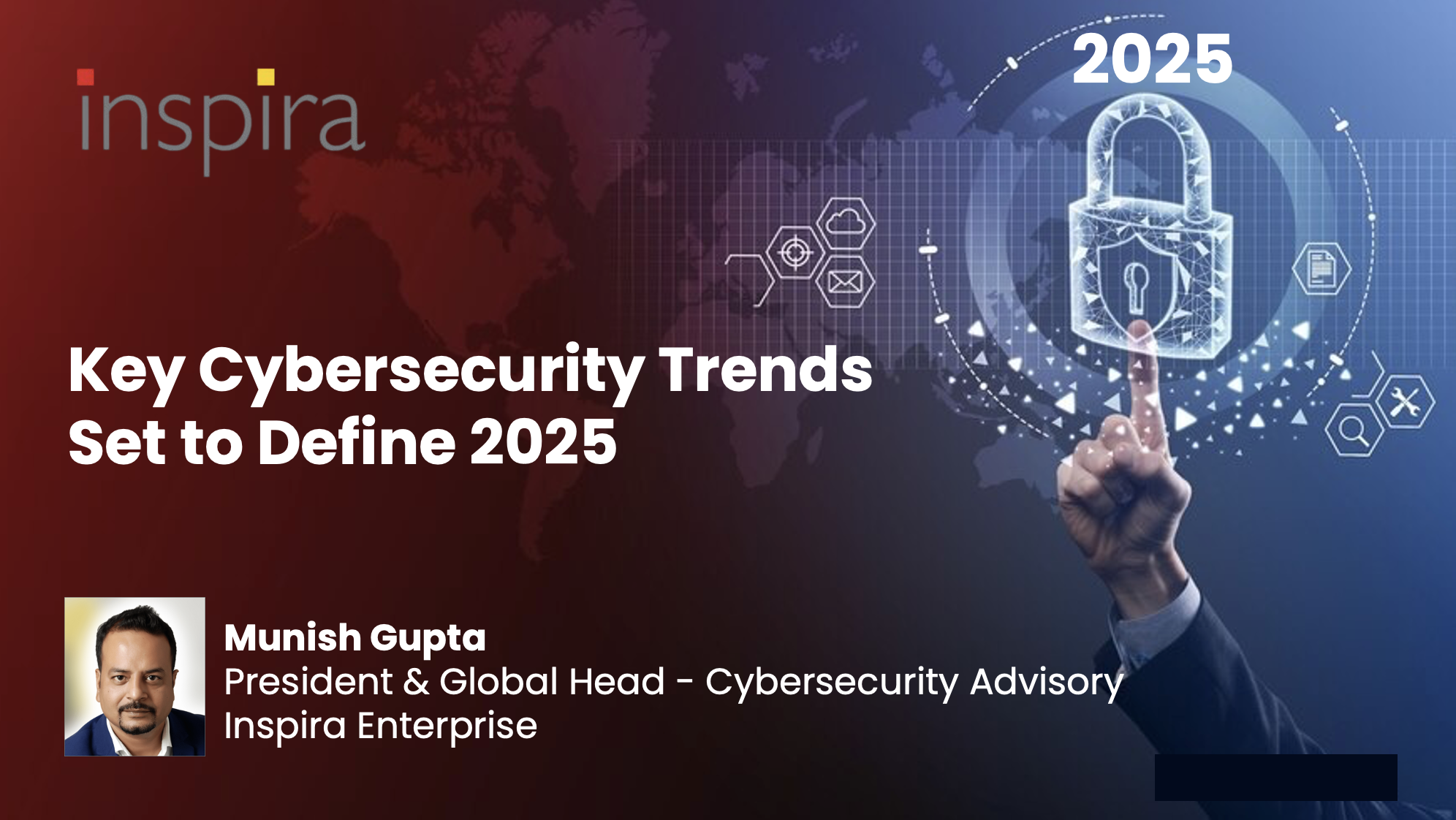Key Cybersecurity Trends Set to Define 2025 - Munish Gupta, President & Global Head, Cybersecurity Advisory, Inspira Enterprise

The acceleration of
digital transformation efforts and the interconnected digital landscape have
captivated cybercriminals to steal corporate data and personal information from
organizations and individuals for huge financial gains. In recent times, these
intruders have been utilizing innovative technologies and tools and are
constantly on the prowl to achieve their objectives quickly. The year 2024 was a breakthrough for
cybersecurity with both technological advancements and unprecedented challenges
where AI was leveraged for cyber defense.
Threat actors, unfortunately, exploited this very technology to launch
cyber-attacks leading to an unprecedented increase in their volume and
complexity besides the huge associated cost that is growing at an alarming
rate. The global cost of cybercrime is
expected to surge in the coming years, rising from $9.22 trillion in 2024 to
$13.82 trillion by 2028, according to estimates from Statista’s Market
Insights.
Now shortly, as we step into 2025, we will see the cybersecurity landscape getting even more complex with newer challenges and sophisticated technologies, creating a dynamic threat environment. let's explore the key cybersecurity trends and what to expect in the year 2025
- Growing importance of AI for threat detection and proactive
measure
AI today is an indispensable technology for cybersecurity defenders to get ahead in the mutable cyber landscape. Sophisticated AI algorithms and machine learning are driving the process of identifying threats, analyzing them, and effectively responding to them while minimizing the overall risks. These advanced AI algorithms enhance the overall cybersecurity of the organization while easing the workload of SOC teams. With AI maturing as a technology, evident today in GenAI, organizations can expect to enhance their threat detection capabilities enabling teams to progress from remaining reactive to becoming proactive in the coming year.
- Securing AI models to become a crucial priority
2025 will be driven by securing AI models and ecosystems to secure LLMs and maintain confidentiality, integrity, and privacy. In the coming days, cybercriminals will increasingly attempt to access sensitive training data that underlies the AI model. They can manipulate the model to decrease its predictive accuracy. Availability attacks can make the AI model unusable by blocking access and increasing its error rate. Some of the attacks include evasion, model inversion, model stealing, data poisoning, and more. To avoid such incidents, organizations have to implement strict security measures during model building and execution stages.
- Quantum Computing and associated challenges
In recent months quantum computing’s advent though in its nascent stage has made a shift from classical computing. It harnesses quantum mechanics to solve problems far better than classical ones. However, this new technology has the potential to crack even very advanced security measures such as breaking the cryptographic keys used in encryption. It has the potential to become a cybersecurity threat. Therefore, organizations must adopt quantum-safe cryptography to secure data such as Lattice-based encryption among others as early as 2025.
- Changing Cyber workforce landscape
SOC’s L1 tasks which involve sifting through massive amounts of data and alerts can lead to alert fatigue for the analytics due to its repetitive and time-consuming nature. 2025 will see such tasks getting replaced by AI systems as they can effortlessly handle mountains of data consistently at a far quicker pace too. To fully leverage AI technology here, SOC professionals must learn to adapt to the change. They should consider cross-skilling and develop new skills to responsibly harness AI power. Analysts should develop expertise in machine learning and data science among other skills to be relevant and contribute better to the changing landscape. In the coming year, AI will be redefining SOC and transforming the cyber workforce scenario.
- Data Privacy will be given top priority
With new laws and growing awareness, the data privacy landscape will transform in the coming year. It will become the key boardroom discussion point of 2025 with countries increasing focus on the new laws and regulations around privacy to navigate challenges offered by AI and rapid technological advancements. In India, the data privacy framework will be defined by the DPDPA (Digital Personal Data Protection Act) which was passed in August 2023. In the year 2025, this law is expected to be in place and will be driving corporate strategies with senior management putting in significant efforts to ensure their organizations are meeting the mandates.
- Crisis Management readiness is key
Increasing ransomware attacks and managing them are already giving nightmares to CISOs. The hybrid work model and BYOD culture of today have contributed immensely to the expanding attack surface. All organizations have to anticipate threats, reassess their cybersecurity strategies, and build the necessary resilience to comfortably navigate the fast-evolving digital landscape. Organizations have to regularly leverage offensive cybersecurity strategies and assess preparedness. They also have put in place a robust cybersecurity strategy, besides nurturing a security-first culture across the organization.
- Protecting Critical Infrastructure becomes significant
State-sponsored threats
and hacktivism driven by geopolitical events can target critical national
infrastructure and bring energy, healthcare, and other essential services to a
halt, causing maximum damage. Only coordinated
efforts between the public and private organizations can ensure no disruptions
to essentials and lifesaving services.
Some of the key technologies that cybersecurity defenders employ include
network segmentation, implementing ongoing monitoring solutions, and encryption
of sensitive data, among others. In
2025, AI and ML will be leveraged extensively for identifying vulnerabilities
and defending critical infrastructure.



